
TUESDAY




TUESDAY


By Jacquelyn Burrer News Reporter
Students at Alamito and Cibolo Halls quickly began reporting numerous maintenance issues, such as malfunctioning outlets and recurring elevator outages, after fall move-in.
According to records obtained by The Star in a public information request (PIR), the first outlet outage was reported on Aug. 7, with similar outages occurring during move-in week starting Aug. 17.
As of March 7, at least 2,580 total maintenance requests were filed for Alamito and Cibolo Halls, according to the PIRs. Since the start of the academic year, electrical problems made up 39% of all requests. However, since Nov. 3, they have accounted for 63% of reported issues.
Construction on Alamito and Cibolo Halls, also known as Hilltop Housing, began on June 28, 2019. Texas State paused construction in 2020 due to COVID-19 and resumed in May 2022.

A university representative wrote in an email that the university is committed to ensuring the
By Ryan Claycamp Assistant News Editor
The city of San Marcos is offering an additional way for the public to engage with the city’s annual budget process.
The new budget interaction opportunities come in two phases. The first phase was the Balancing Act budget prioritization tool, which closed on March 17. The second phase, which will be open from May 1 to 15, will allow residents to propose how money should be allocated.
health, safety and wellbeing of students, faculty and staff but did not specify how the university is addressing the issues.
“Texas State Housing and Residential Life, and Facilities, Planning, Design and Construction are aware of issues within Alamito and Cibolo Halls and are actively working with the contractor to correct the issues,” the representative wrote in an email.
Additionally, Vaughn Construction, the company that built the dorms, refused to comment and said in an email they were instructed to direct all questions to Texas State Facilities.
According to records from the PIR, the cause of the electrical issues is malfunctioning arc fault circuit breakers purchased from Siemens, a global technology company.
Kyle Estes, director of Housing Facilities Services at Texas State, acknowledged the widespread breaker issues in an email obtained via the PIR.
By Sydney Seidel Life & Arts Contributor
Walter Wright, associate professor of political science, had a stern side according to many of his students, but he was also a “teacher to all” who made everyone feel welcome. His impact made him a driving force in the legal studies department at Texas State.
His students and his field remember his dedication even after he died of a heart attack on Dec. 28, 2024.
The Texas Association of Mediators held a memorial service for Wright on March 3, bringing together past colleagues and students to celebrate his life and legacy.
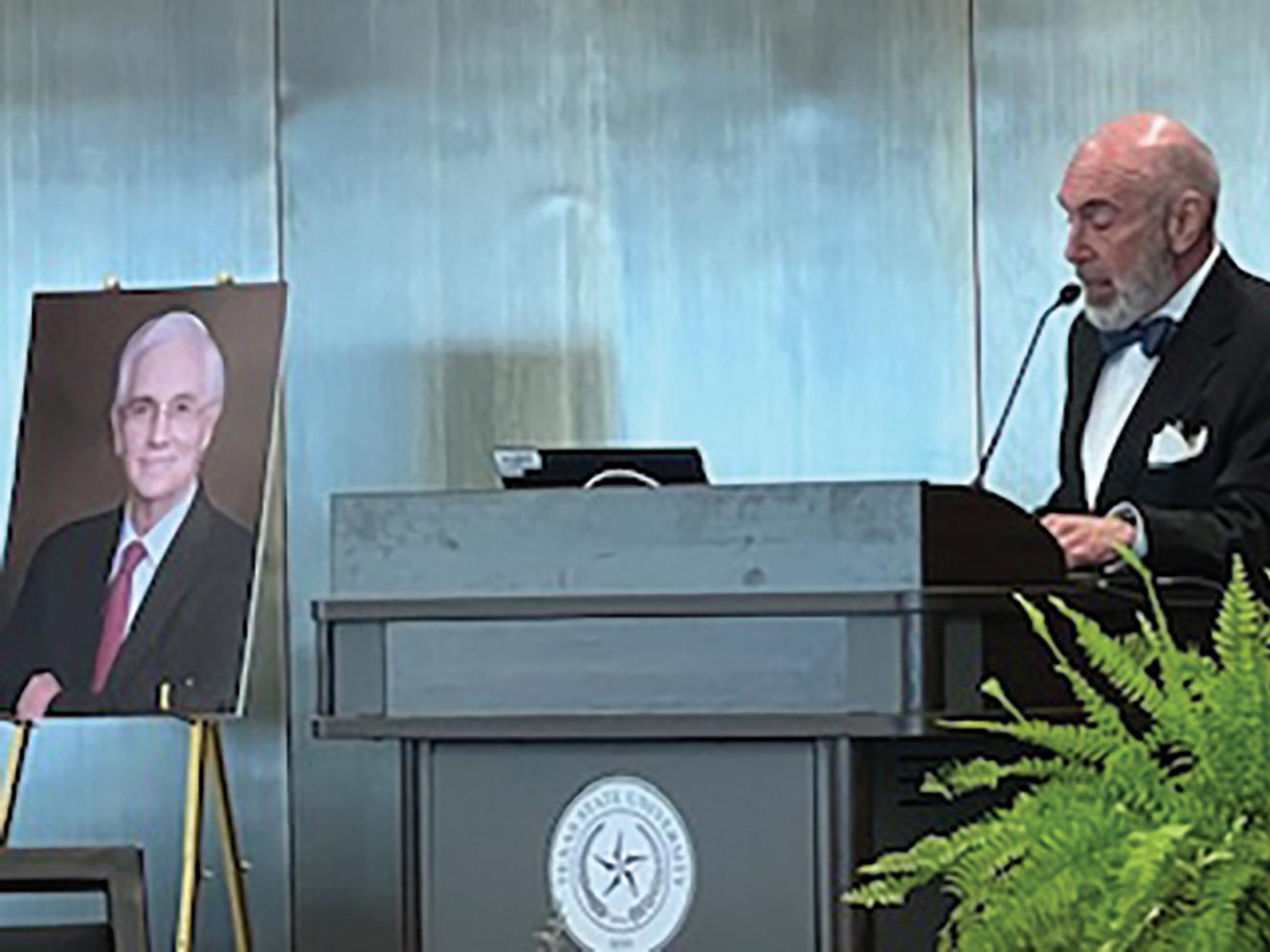
Texas lawmakers seek to restrict DEI courses
By Arabella Dichristina News Contributor
“Inside the Capitol” examines key bills from the 89th legislative session that impact the Texas State and San Marcos communities. The session began on Jan. 14 and ends June 2.
Courses focusing on Diversity, Equity and Inclusion (DEI) topics are at risk of getting restricted or banned under a new bill in Texas’ 89th legislative session.
State Rep. Cody Harris, R-Austin, introduced House Bill 2548 (HB 2548) that would prohibit colleges from requiring students to complete courses that contain DEI topics.
What is the bill proposing?
According to HB 2548, any course required as a degree requirement or general education containing any listed topics will no longer be
mandatory. Some banned topics include: Critical theory, whiteness, gender identity and systemic racism.
An exemption to HB 2548 would include DEI-focused degree plans and history courses, which will be allowed to discuss historical events related to racial hatred or discrimination.
According to HB 2548, general education cannot include theories that claim the U.S. was designed to maintain inequalities. For Texas State, some classes that are at risk of being canceled if the bill becomes law are Negotiating the Color Line, Global Issues in Diversity and Gender, Sex and Power.

Tuesday, March 18, 2025
“For some reason at Hilltop, the breakers have been regularly tripping supposedly for arc fault…it has been 99.9% arc fault issues…,” Estes wrote. “Unfortunately we seem to have a variety of contributing factors that have made it nearly impossible to fully eliminate the problem.”
An electrical arc occurs when electricity transfers from one connection to another. Arc fault, which is the recurring problem at Alamito and Cibolo, occurs when electricity takes a path it isn’t supposed to, creating a spark or “arc,” which can lead to fires.
After the 2020 update to the National Electric Code, all dorm bedrooms must have arc fault circuit interrupters (AFCIs) installed to detect dangerous electrical arcs and prevent fires by shutting off power when irregularities are detected.
Estes wrote the breakers trip due to a variety of reasons, including issues in the wiring installation or something to do with a device the resident had in the room.
A 2022 class action lawsuit filed by a group of consumers and electricians alleges that Siemens’ AFCIs “fail to adequately distinguish between harmless and dangerous electrical arcs,” resulting in the breakers repeatedly tripping with no real cause, according to the lawsuit.
“[Housing, Facilities and Services] staff members in Hilltop begin and end each day with checking every electrical panel in Hilltop and resetting any breakers they find.”
Some students have reported power outages lasting anywhere from a few hours to several days, particularly on weekends when maintenance services are limited.
Ava Rapley, a diagnostic medical sonography freshman, said her outages started in October.
“I was losing power every 7 to 14 days,” Rapley said. “Basically, I’d put in [maintenance requests], and I think they would just temporarily fix it, but they weren’t actually going to fix the problem….it was really awful.”
Rapley said the only communication she received from Texas State about the issue was an email this spring saying there may be temporary power outages, but she received nothing from the school last semester.
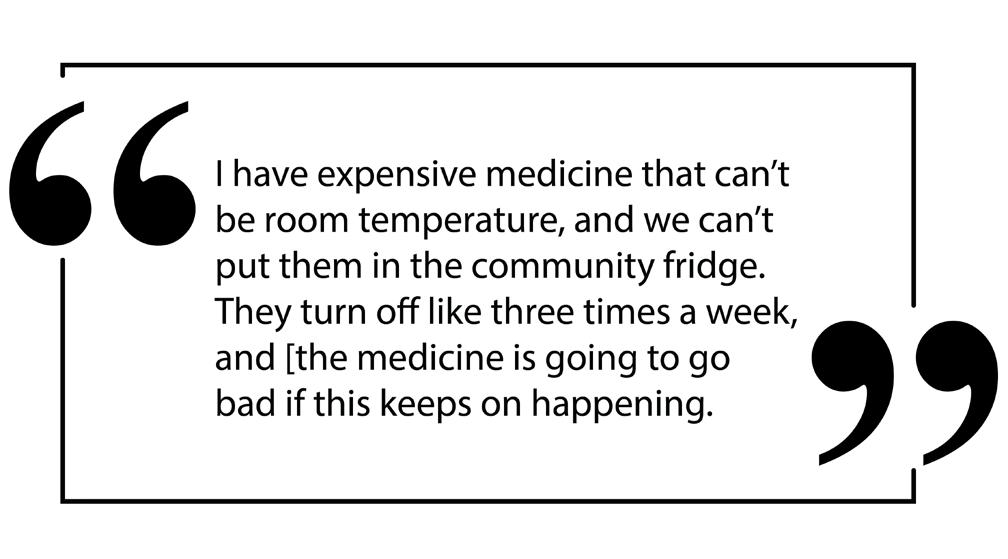
Specifically, the plaintiffs allege that Siemens’ AFCIs are “effectively unusable” and that the company “has been unable, or unwilling, to update its AFCIs to recognize harmless arcing signatures created by the normal use and operation of everyday appliances.”
While Siemens’ motion to dismiss the case was partially granted in 2024, the court allowed claims related to the fraudulent concealment of malfunctioning equipment to proceed.
According to Estes, Vaughn Construction and their electrical sub-contractor implemented the recommendations Siemens staff and engineers made, including adding radio frequency surge protectors in rooms with recurring outages issues.
“While those efforts seem to have had a positive impact in some areas of the building, it has not eliminated all issues,” Estes wrote in an email.
“This is crazy how much [the power outlets] keep turning off,” an Alamito resident wrote in a maintenance request from Sept. 22 obtained via PIR . “I have expensive medicine that can’t be room temperature, and we can’t put them in the community fridge. They turn off like three times a week, and [the medicine is] going to [go] bad if this keeps on happening, and it takes super long to get more medicine, so I’m going to be very upset.”
On Oct. 13, another Alamito resident wrote the outages caused her to waste food due to her mini-fridge not working.
“[The outlets] have constantly gone out,” the Alamito resident wrote on Oct. 13. “I am paying out of pocket for my tuition and expect that my living arrangement [will] reflect that. I would appreciate [if] someone can be sent up here that will actually fix the issue, and I won’t need to constantly have maintenance in my room or have to fend for myself on weekends when facilities isn’t open.”
According to the PIRs, Alamito and Cibolo are both under warranty until Sept. 30, 2025, but additional emails say they are under warranty until August, which would be a year after the buildings’ completion dates.
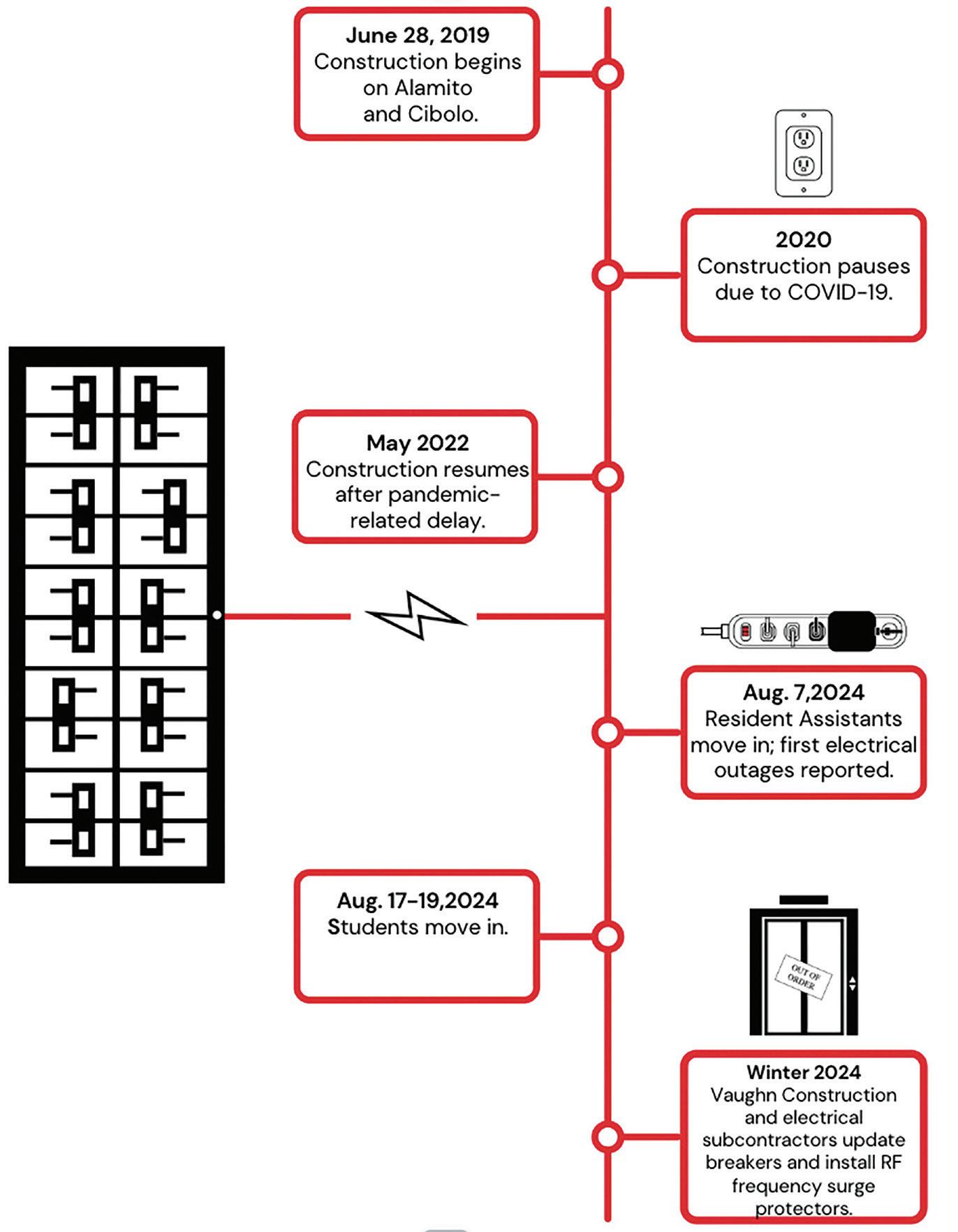
Once warranty runs out, costs are no longer covered by Vaughn and Texas State would foot the bill.
Once the warranty expires, any necessary repairs or maintenance will likely no longer be covered by Vaughn Construction, leaving Texas State responsible for the costs. Additionally, all maintenance issues covered by warranty must be worked on by Vaughn’s staff, according to the PIR.
Residents also reported ongoing issues with the elevators, with numerous students getting stuck in the elevators at Alamito and Cibolo.
In an email chain from the PIR discussing a recent elevator outage, Director for Housing Facilities Services Henry Moreno wrote on Jan. 28, “When will these elevator[s] actually work 100%?”
Various maintenance requests said residents were often stuck in the elevator due to the doors not opening once they reached the first floor.
In an email following the elevator malfunctions obtained via PIR, Texas State Facilities Operations Construction Manager Tim Haley wrote, “[Technicians] are going to
look at the Elevator Braking Systems on all 4 of the elevators if possible to determine why there have been so many Service Calls concerning the Braking Systems on these elevators since the building opened.”
Rapley said the elevator outages were more of an issue last semester and that the problem has been improving this semester.
“Our elevators would go out a lot,” Rapley said. “We always just figured it was because it’s a new building, and they’re still figuring it out…A lot of us [got stuck in the elevators].”
While solutions such as installing surge protectors have worked to solve the problem, electrical and elevator issues at Alamito and Cibolo remain unresolved, with no permanent solution in sight.
It remains unclear whether Texas State will use Siemens’ AFCIs for the new dorms, but under the National Electric Code, the university is required to use AFCIs, leaving the possibility that future dorms could face similar electrical issues depending on the university’s chosen manufacturer.
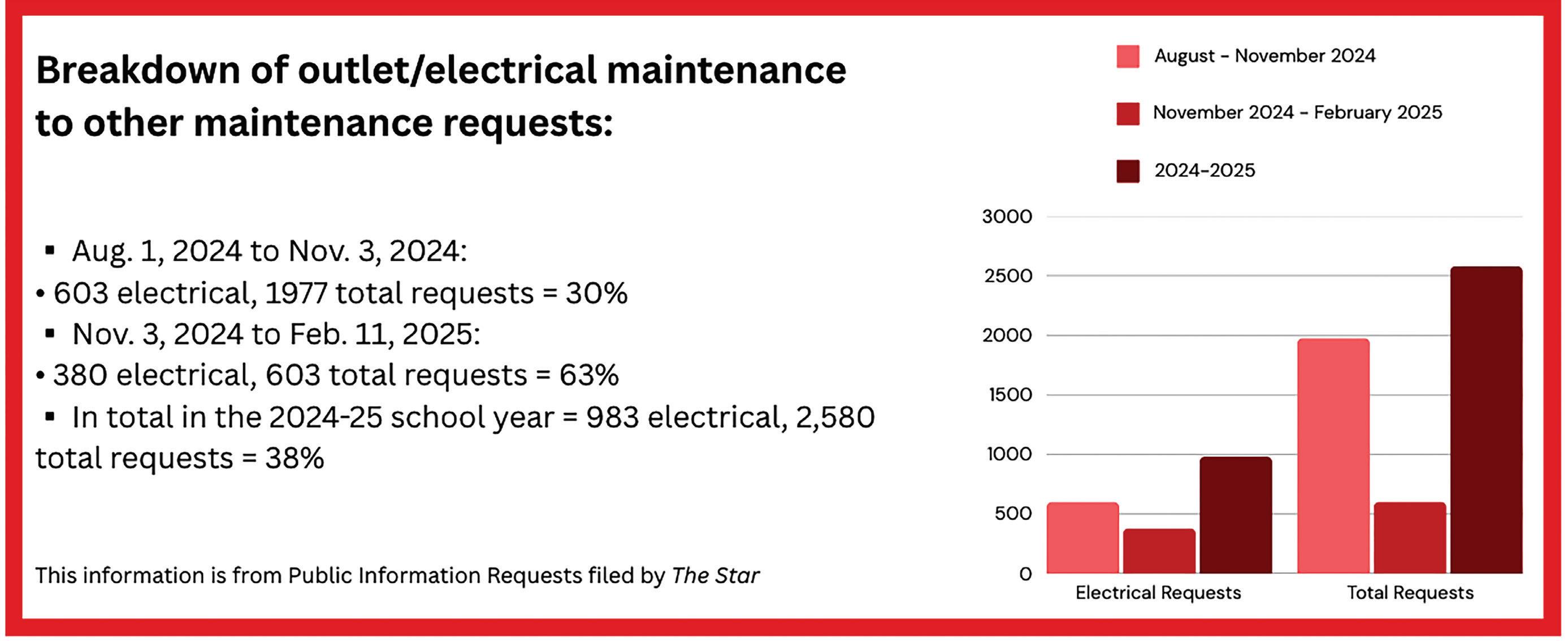

Trinity Building 203 Pleasant St. San Marcos, TX 78666 (512) 245 - 3487
History: The University Star is the student newspaper of Texas State University and is published every Tuesday of the spring and fall and once a month in the summer semesters. It is distributed on campus and throughout San Marcos at 8 a.m. on publication days with a distribution of 3,000. Printing is by the New Braunfels Herald-Zeitung.
Read more at universitystar.com

Editorial Staff
Editor-in-Chief: Marisa Nuñez stareditor@txstate.edu
Managing Editor: Blake Leschber starmanagingeditor@txstate.edu
News Editor: Lucciana Choueiry starnews@txstate.edu
Life & Arts Editor: Carlene Ottah starlifeandarts@txstate.edu
Opinions Editor: Rhian Davis staropinion@txstate.edu
Design Editor: Jen Nguyen stardesign@txstate.edu
Sports Editor: Jackson Kruse starsports@txstate.edu
Multimedia Editor: Mandalyn Lewallen starmultimedia@txstate.edu
Engagement Editor: Diego Medel starengagement@txstate.edu
PIR Director: Katherine Andrews starpr@txstate.edu
Creative Service Director: Carson Rodgers starcreative@txstate.edu
Director: Laura Krantz, laurakrantz@txstate.edu
Publication Info
Copyright: Copyright Tuesday, March 18, 2025. All copy, photographs and graphics appearing in The University Star are the exclusive property of The University Star and may not be reproduced without the expressed written consent of the editor-in-chief.
Corrections Policy: Errors appearing in the pages of The University Star and brought to our attention will be corrected as soon as possible.
Advertising Inquiries Contact at: 512-245-3487 advertising@universitystar.com
“This tool was sought as part of our commitment to transparency and collaborative decisionmaking, allowing residents to directly contribute their insights and ensure that our spending decisions are aligned with their needs, creating a more responsive and inclusive government,” San Marcos City Manager Stephanie Reyes wrote in a press release.
The Balancing Act tool allowed residents to rank their top 10 priorities from a list of 26 topics such as community safety, housing affordability, public transit and more.
The second phase will utilize a budget simulation tool to allow residents to give their opinions of real-word scenarios and the trade-offs that go into balancing a city budget.
According to Trisha Patek, budget manager for the city of San Marcos, increases in staffing for the city’s finance are allowing to increase focus on community engagement where they previously have not been able to.
In the past, the public was able to provide feedback on budget proposals during public comments at city council meetings and work sessions, as well as by contacting members of the city council directly. The city hopes the additional ways to participate in the budget process will make it more accessible for San Marcos residents.
“We hope that this tool would also be another way for people to engage with

the budget and the way that we decided to structure it was so much of the budget is tied to the strategic plan,” Community Resource and Engagement Coordinator Grisell Perez-Carey said. “So let’s launch this priorities tool to really ask for people to give us their priorities based off of the strategic plan, and then that information will be shared with city leaders as the budget kind of takes shape.”
According to Patek, the city also has “dream sessions” which are sessions where residents can openly communicate their desires for the budget process. San Marcos Resident
HB 2548 text says higher education governing boards should not require courses where students receive a grade for topics that “promote the differential treatment of any individual or group of individuals based on race or ethnicity in contemporary American society.”
According to Assistant Vice Provost for Curriculum and Academic Programs Jeff Housman, funding for class curriculums is based on formula funding, where the state gives funds based on the number of students in a specific course and major.
The funding also comes from the Texas Higher Education Coordinating Board (THECB), where there is a pre-determined value for each type of major, Housman said. This system also depends on the number of students enrolled in each major.
Chase Norris attends the San Marcos dream sessions. He said the sessions give him insight into the difficulties the city faces when deciding where to spend money.
“I went to the Community Development Block Grant dream session,” Norris said. “We were given a budget of $700,000 which is how much money the city is getting. It was challenging because San Marcos has a population of about 91,000 and 33,000 of them are in poverty. So if you do the math, that’s about $21 per person in poverty.”
The first real step of the budget process is to forecast how much money the city
can actually budget for, Patek said. She said for FY2026, which is the year the city is currently budgeting for, the budget is expected to be lower than FY2025’s $342 million budget.
Patek said that means following resident recommendations this year would likely involve redirecting money and not spending more money.
“The idea of this tool this year is to get a sense from community members that participate, what kinds of things they’re looking for to see,” Patek said.
Patek said suggestions made this year will be kept
“There seems to be a decline in students actually wanting to learn, so I feel like if [students] don’t have to take a class, they won’t,” Williams said.
Williams said without state funding, some organizations like his may try to fund courses, but
so they can be used to make changes in the long term, not just for next year’s budget. Norris said in the dream sessions city staff has made it clear that while they value the recommendations, the final budget allocations are ultimately up to city council to decide.
“We hope that these things were taken into account when the decision makers put their stamp of approval on it or make any changes to [the budget],” Norris said. “But at the end of the day, if people are paying attention to this kind of policy, if you don’t agree with what the decision makers are making, they are elected.”
According to Nadine Cesak, San Marcos’ communications and IGR manager, the recommendations will also be used to make changes outside of the budget process.
“Even if there’s not dollar amount that’s tied to a priority that’s mentioned in this budget tool, if we get an overwhelming response from our community... are there other things that we can do within our acting capacity right now to help kind of meet that need or meet that priority?” Cesak said.
Scan the QR code for more information on the budget.

professors will have to pick between keeping themselves fed and teaching the students the right history.
Housman said, Texas Higher Education Coordinating Board is very focused on majors that will help boost the Texas economy.

“[Provost’s] role is to help coordinate the faculty review process, and the other part is to ensure compliance with [THECB] policies and state laws,” Housman said.
Texas State NAACP President Jordan Williams said not requiring DEI-focused courses will minimize the education that students receive.
there wouldn’t be enough money to carry out the programs.
“[Provost] wants our students to have strong programs so that when they leave that are employable,” Housman said.
Williams said professors will be teaching a watered-down history, and if the bill passes,
“Just because people feel like [DEI topics] don’t make sense anymore and talking about it still carries it on. But if that’s the case, why are we still learning about Christopher Columbus?” Williams said.
According to Williams, the NAACP is swamped with messages, calls, and emails about the current Texas administration.
“Why do we get to nitpick which parts of history we’re teaching, but when it comes down to the worst parts of [history] we’re not allowed to speak about it,” Williams said.
HB 2548 has been introduced to the house, where it will be referred to a committee for discussion before being voted on whether to present it to the full House.

Scan the QR code to read HB 2548.

March 18, 2025
Opinions in The University Star are not necessarily those of our entire publication, Texas State University’s administration, Board of Regents, School of Journalism and Mass Communication or Student Publications Board.
By Aubrey Haynes Opinion Contributor
Texas State has a recurring cycle of hazing and hazing-related deaths among its fraternities. The deaths of Nick Armstrong in 1999, Jordin Taylor in 2016 and Matthew Ellis in 2017 highlight the ongoing issue.
Texas State fails to punish hazing and continues to allow dangerous practices within Greek life, which demonstrates the university’s indifference to student safety.
The university’s response to hazing related deaths has typically been limited to disaffiliation and shielding the university’s reputation.
Disaffiliation means fraternities lose “official status” but can still operate off campus without rules or oversight. As a result, hazing continues, just without Texas State’s name attached.
Joseph Wright, a 2001 graduate, said he vividly remembers the unsettling atmosphere of the Tau Kappa Epsilon (TKE) fraternity house. He said the fraternity was known for its hazing culture. When a student’s death during a TKE bid party prompted the fraternity’s suspension, conversations around Greek life took a darker turn.
In February 1999, Armstrong died from hazing practices. He was found unresponsive in the living room of the TKE house after consuming excessive alcohol as part of an initiation ritual. In response, Texas State suspended TKE.
“The house, during parties, was covered in black trash bags, a symbol of the hazing and drugged drinks,” Wright said. “But this was different. It was more than an assault. The

university did not do enough.”
Rather than supporting the mourning family, Texas State chose to distance itself from the issue, enabling the cycle that stands today.
Texas State’s hazing policies are based on the Texas Education Code, which defines hazing as any act that endangers a student’s safety. The law imposes penalties, including felonies for hazing resulting in injury or death.
Despite this, recruitment activities managed by the Interfraternity Council (IFC) happen year-round, with little awareness of hazing risks. The university’s inconsistent enforcement allows hazing to continue as long as the IFC oversees the process, operating with minimal oversight and protecting fraternities from accountability.
In 2016, Taylor died after she was dragged by a party bus following a fraternity party hosted by Pi Kappa Alpha. Four involved fraternities were suspended for alcohol violations,
but the underlying issues leading to the tragedy were not addressed, resulting in another death just a few months later.
Ellis, a 20-year-old Phi Kappa Psi pledge, died due to alcohol poisoning. He was found at his apartment after an off-campus fraternity tradition of bourbon gifting to signify brotherhood. Pi Kappa Alpha, Alpha Tau Omega, Kappa Alpha and Delta Tau Delta disaffiliated from the university not long after the death.
In a statement, university spokesman Matt Flores said the groups were told to suspend campus activities for 2-5 years depending on involvement. Yet, this response still allowed hazing to continue.
No sororities have disaffiliated, proving accountability is possible without severing all affiliations. Texas State has the tools to require training, reporting policies and holding Greek life organizations accountable. Administration chooses not to and
actively endangers students.
Saide Lopez, a Texas State graduate and Sigma Lambda Gamma member, said she had a positive experience in Greek life. She said she believes ending Greek life would deprive students of meaningful experiences.
“I was introduced to a community of women who became my family at a time when most students feel isolated,” Lopez said. “Not everybody hazes... it’s bonding, networking and having a home away from home.”
However, Best Colleges data indicates that over 55% of students in all organizations are hazed, and most incidents go unreported. Doing away with fraternities won’t eliminate hazing; it will only push it underground.
Texas State needs to be more proactive by exercising more surveillance during the initiation period, along with random sweeps of fraternity off-campus activities. Anonymous reporting policy on hazing infractions could also be implemented, like at Texas Tech, so students would feel comfortable reporting infractions without fear of retribution.
Because initiation season is in full force, Texas State’s failure to prevent hazing allows a dangerous culture to thrive. Shutting down frats is not the answer, and sweeping it under the rug as “boys will be boys” just allows more violence to ensue.
Texas State must increase transparency and hold organizations accountable. Otherwise, there will be more students at risk.
-Aubrey Haynes is a social work freshman
By Hannah Nunez Opinion Contributor
From as early as middle school, students are encouraged to begin pursuing volunteer and internship opportunities, but now these experiences are becoming more crucial than ever.
As competition for jobs intensifies, internships have shifted from being an advantage to a necessity. Because of this, fewer opportunities are available. Texas State Students, however, are at an advantage due to campus resources and opportunities.
As students reach the second half of the spring semester, many are using this time to evaluate academic and professional pursuits.
This means beginning the process of applying to summer internships or organizing future volunteer experiences, but the climate of these opportunities is not what it used to be. Instead, the increasingly competitive job market is driving a shift like never before, turning these ventures from nice-to-have to must-have.
Many recruiters believe a factor that plays into internships becoming necessity is rising application rates accompanied by a decrease in internship listings overall.
According to The National Association of Colleges and Employers, 66.9% of 2024 graduates participated in an internship during their college career. This is the highest percentage recorded in the past 6 years.
Despite this, a new report from student job platform Handshake states from 2023 to 2025, internship listings declined by more than 15%, leaving students discouraged and overwhelmed by competition.
Gabriella Thurow, psychology sophomore, said she is struggling with the increased competition
rates. She said her internship hunting experience was confusing and overall depressing.
“It’s hard to stay encouraged when you know that logistically, the odds are pretty much against you,” Thurow said. “I’m hoping to get an internship so I can learn the skills I need for future employment, but in order to even be considered, I’m expected to already have those skills.”
Internships are supposed to allow students to grow their skills through involvement and avoid the frustrating cycle of needing experience to get experience, but this has only become more complicated with AI advancements reshaping what entry-level roles look like.
According to Forbes, many traditional entrylevel positions are being reduced or replaced by

technology, and in turn, discarding jobs that once acted as stepping-stones for recent grads.
Students are expected to leave college with more experience than ever before, but are simultaneously given the least amount of opportunity to gain experience.
While the climate of the job market is intimidating, Texas State students have the advantage of utilizing both career and mental health counseling. Resources such as Career Services break down the fear associated with future employment by guiding students along the path to their goals. Students are simultaneously encouraged to sustain a healthy work-life balance in this stressful climate with mental health services like the Counseling Center and Therapy Assistance Online.
“I’d rather utilize the school departments that my tuition is going towards than give up,” Thurow said. “If this is how the job market is, I don’t think we have any other choice than to adapt and keep doing what we can with the resources we have.”
-Hannah Nunez is a journalism senior
letter writer. It is not used for any commercial purpose.
Letters become the property of The Star and may be republished in any format. The letter may be edited for length and clarity. An editor will contact the letter writer if their letter is a candidate for publication. The Star will not run letters that are potentially libelous, discriminatory, obscene, threatening or promotional in nature.
Letters can be submitted to staropinion@txstate.edu or by mail to Attn: Opinion Editor, The University Star, 601 University Drive, San Marcos, TX, 78666.




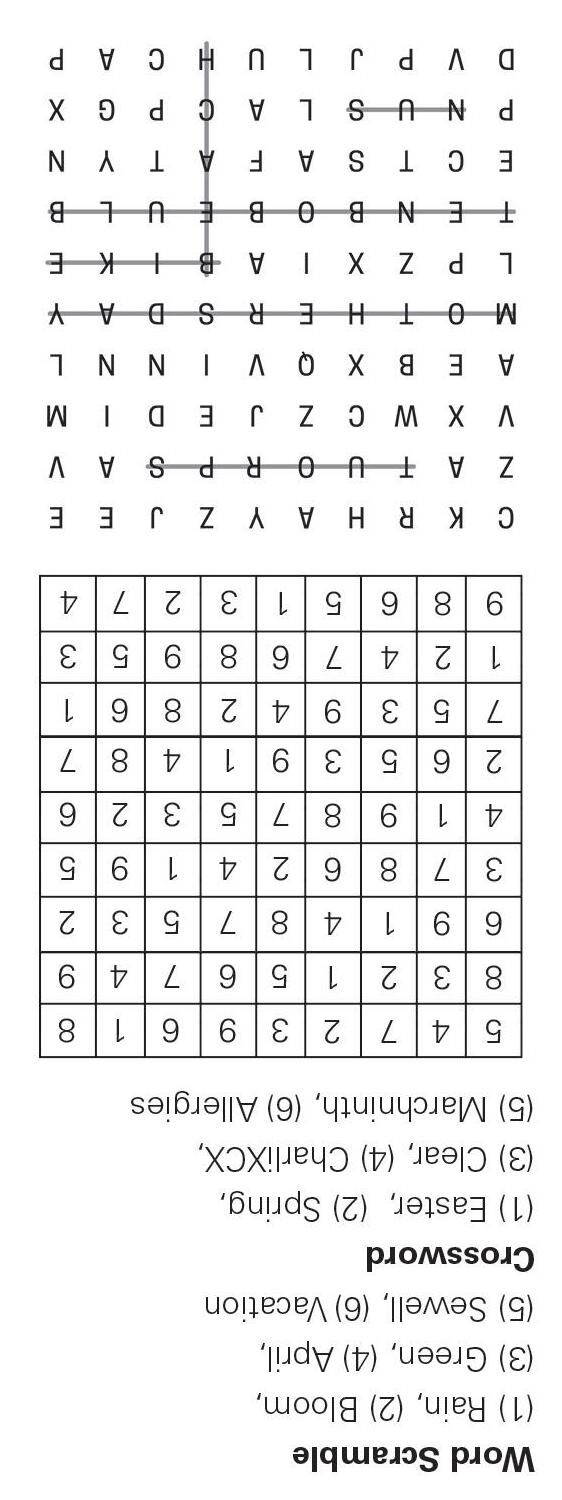



Tuesday, March 18, 2025
By Marisa Nuñez Editor-in-Chief
Different works of art created by Texas State students, faculty, staff, alumni and retirees cover the walls and panels inside the San Marcos Art Center for March.
Inspired by lyrics from the Texas State “Alma Mater,” Green Hills Rising is the San Marcos Art Center’s third exhibition featuring Texas State students and alumni. This year, to “broaden the scope,” the exhibition includes Texas State faculty, staff and retirees.
“It isn’t just students anymore, that’s the difference,” Nancy Brown, director of the San Marcos Art Center, said. “It’s a very successful show. It’s nice to be able to tie into Texas State, to coordinate with them and collaborate with them.”
Due to changes in the exhibition, Gwendolyn Hustvedt, a professor of family and consumer sciences, had the opportunity to participate in this year’s showcase. In the past, Hustvedt attended the exhibition to view student work, but this year she feels honored to be a part of it.
“I wasn’t so lucky as to be a Texas State alum… but I got here as good as I could… I’m glad that we opened it up to retirees and staff members, faculty and alumni as well as students, so we get to have the dialogue about our experience of this beautiful community [through the exhibition],” Hustvedt said.
Hustvedt’s piece is batik on silk, an ancient textile art technique using rice paste and dyes to paint designs on silk fabric. Her passion for the art technique began in 2016 after she took a silk painting workshop, at the London Museum of Fashion and Textiles.
“It’s always exciting when you get to show your work and meet your audience because that’s valuable to understand how people are seeing what you’re doing,” Hustvedt said. “I’m excited to have that chance to be part of the student group; it’s really meaningful to me.”
Attendees can view mixed media, oil, acrylic, watercolor,
FROM FRONT REMEMBRANCE
Wright, who taught in Texas State’s master’s program in legal studies, began his teaching career in 1997. Having already established himself in the mediation community before transitioning to academia, he quickly adapted and became a professor who was “universally respected and adored,” a phrase echoed multiple times during the ceremony.
Alandra Rivera, legal studies graduate student, was one of Wright’s students at the time of his passing. She recalled his kindness toward his students, noting that while he had high expectations in the classroom, he was always there to support them in their studies.
“These classes can take a toll on you,” Rivera said. “But he never wanted to see any of us fail, and I’ll always carry that with me.”
Wright was most recognized for his work in mediation and conflict resolution, both domestically and throughout Latin America. His passion for the region stemmed from his high school years when he and his brother raised money for a trip to Mexico with their Spanish class. At his memorial, those closest to him reflected on how “Mexico was his transition from Needville [his hometown] into the big world.”
Wright went on to travel across three continents and 14 countries, at one point becoming fluent in Spanish and French. He also became a published author in several of these countries. His work resulted in several cooperation agreements between Texas State and Latin American institutions.
During the ceremony, colleagues, friends and family shared their favorite memories of Wright. While his strict demeanor in class was well
ceramics, photography and several other forms of artwork by the Texas State community.
For Jackelyn Bracamontes, art alumna, the exhibition was not only a place for her to showcase her art but a place to connect with other artists.
“A lot of people here I went to school with, I had a class with or I know from Texas State,” Bracamontes said. “It’s been kind of a reunion in a way which has been awesome.”
Bracamontes made her piece for her thesis at Texas State. She experimented with a new ceramic technique and created a piece while thinking about the body and transformation.
“[I’ve gotten] a lot of positive feedback,” Bracamontes said. “It’s opened conversations about ceramics, and I’ve kind of been like encouraging people to take the community ceramics classes here in town and stuff like that from this.”
Jose Vega, photography alumnus, participated in the first show that featured Texas State students and alumni and was excited to enter again.
“I love that San Marcos has a space for local art,” Vega said. “It’s a very low barrier to entry. It’s like $10, and I think that encourages people to submit the little doodles that they make, the little crafts that they don’t think are gallery-worthy, but you submit them, and then people look at them and [you] get validated.”
Vega’s piece was a picture of a tree he saw on one of his meditative walks and he submitted it because he believed it matched the exhibition’s name.
Kayleigh Melvin, Vega’s friend, came to view his work and was impressed with the artwork made by the Texas State community.
“It’s a really great opportunity to see local art from your local artists, and just to get to know the art scene in San Marcos,” Melvin said.
The Green Hills Rising exhibition will occur from 11:00 a.m. - 5:00 p.m. Wednesday through Friday and Sunday and 10:00 a.m. - 5:00 p.m. on Saturdays until March 28 in the San Marcos Art Center at 117 N. Guadalupe St.


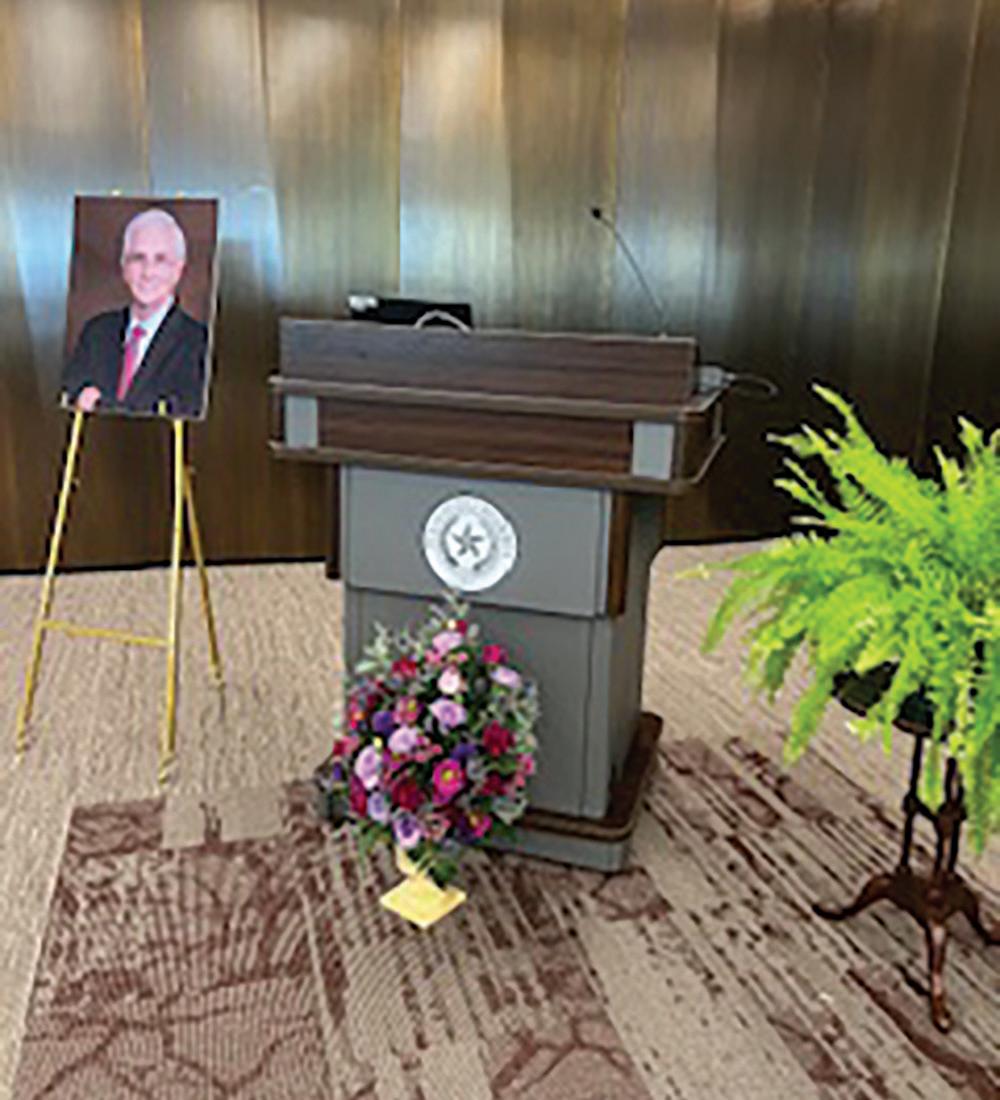
known, he was also remembered for his fun side, which was often marked by what many affectionately referred to as his signature smirk.
Josefina Rendon, his colleague and State District Judge in Houston, recalled the time Wright nicknamed her “mamacita,” believing the term simply meant “little mother.” However, those around him, including Rendon, never corrected him for many years,
not mentioning that “mamacita” was also slang for “hot mama.”
Roger Collins, Wright’s brother-in-law, fondly remembered the first time he met the family when Wright went up to his sister and asked why the man she was bringing home was wearing a necklace. This moment became a family joke. In contrast, Wright was known for always having his shirt buttons fastened all the way
to the top — even when attending aerobics classes, where his workout attire consisted of old polo shirts and long suit socks.
Mari Garza, assistant professor of political science, who was both a student and later a colleague of Wright’s, gave him partial credit for her return to Texas State to teach after he reached out to invite her as a guest lecturer. She believes Wright will be most remembered in the political science department for his significant contributions to the curriculum.
“The curriculum we teach today is his brainchild,” Garza said. “Students who have gone on to become paralegals, mediators and more have carried the tenets of his teachings with them.”
In honor of his passion for Latin America and the work he did there, the Texas State Mariachi Nueva Generación band performed special pieces of music at the end of the ceremony. Cirilo Campos, director of Latin music studies, stated the music is intended to evoke memories of individuals who continue to have a presence throughout a person’s life, even after their passing.
Colton Shelly, who graduated from the legal studies program in August 2023, never had Wright as a professor himself but felt as if he knew him through the stories of his friends in the program. When he heard about Wright’s passing and the ceremony being held, he knew he wanted to attend.
“He’s a founder of this program,” Shelly said. “He’s going to be remembered, whether people knew him personally or not.”
Camp Eagle assistant group camp director Alex Rusch (Left) and summer camp assistant director Jonathan Perez (Right) recruit students during the part-time job fair, Tuesday, March 4, 2025, at the LBJ Mall. Camp Eagle is a Christian adventure camp located in Rocksprings, Texas.
Texas State psychology junior Steven Marchan (Right) and public health senior Lucero Hernandez (Left) purchase merch from Olivia Rodrigo X Lancôme GUTS Tour Experience, Tuesday, March 4, 2025, on The Quad. The pop-up offered GUTS World Tour photo ops and merch.
Morgan’s Camp program manager Truett Dishman (Left) and staff member Jenna Hughes (Right) discuss job opportunities with students at the parttime job fair, Tuesday, March 4, 2025, at the LBJ Mall. Morgan’s Camp is a camp for all abilities in San Antonio.




A Texas State student poses in front of the
GUTS Tour Experience, Tuesday, March 4, 2025, on
The traveling pop-up offered free samples of
fragrance and mascara which were made in collaboration with the
brand.
Scan the QR code to view the gallery online.


By Luke Landa Sports Reporter
Junior thrower Melanie Duron cemented herself in the Texas State track and field record books over the course of her tremendous 2024-25 season.
Duron holds the school record in the shot put event with a throw of 18.21m and placed first overall in the 2025 Sun Belt Conference Indoor Championships.

Class: Junior Hometown: Laredo High School: Martin Career Accolades:
- 2022-23 Sun Belt AllConference Third Team - 2023-24 Sun Belt AllConference First Team (Indoors) - 2023-24 Sun Belt AllConference First Team (Outdoors)
- Texas State Indoor Shot Put Record Holder (16.76m)
As a team captain, Duron helped lead the Bobcats women’s track and field to their fifth Sun Belt Indoor Conference Championship title, and their first since 2019.
“As a captain, one thing I told my girls was you are not only competing for yourself, you are competing for the girl next to you,” Duron said. “This weekend [Indoor Championships], everyone contributed in so many different ways.”
Texas State women’s head track and field coach John Frazier has worked with Duron over the past three years. Frazier always believed Duron was supremely talented, but it came down to both her work ethic and the trust of her coaches that would ultimately dictate her success.
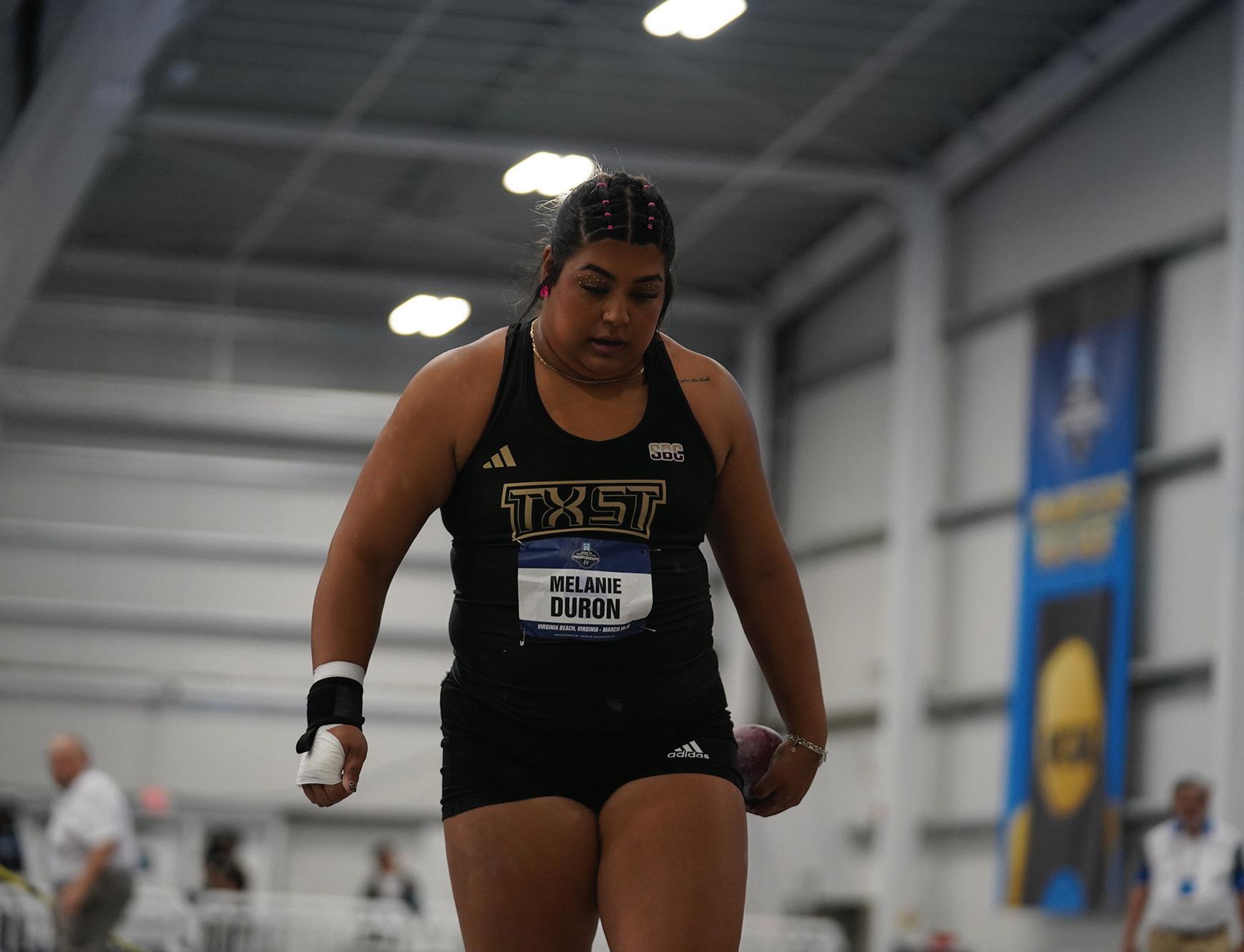
“Every workout [Melanie] got better, even when she questioned [the change of technique],” Frazier said. “After the winter break, her very first throw in the first competition was almost a sense of relief because she did a real throw in a real competition, and it was literally her best opening mark [compared to] the old technique.”
While Duron had always been solid at the shot put event, she trusted her coaches enough to allow them to change her technique.
“[Coach Frazier] had so much
By Grace Darcy Sports Reporter
Maria Jose Martinez joined the Texas State Bobcats coaching staff as the assistant golf coach in January, aiming to share her golfing experience with the team and foster the “better together” team culture.
Martinez joined the staff with a fondness for the team culture that current head women’s golf coach, Par Nilsson, created.
Gaining this role with the Bobcats gives Martinez the opportunity to continue to grow and connect with the sport.
still very close to most of my college coaches and they’ve helped shape me as a golfer and a person.”
This collegiate experience assisted Martinez in her new role with the Bobcats. Martinez is able to pass down her collegiate experience to the team and relate to them on and off the golf course.

“I would say it’s kind of like my way of giving back to the sport,” Martinez said. “Golf really gave me the best relationships that I’ve ever had, both professionally and personally.”
Texas State women’s golf assistant coach
“It’s more of a trust thing,” Martinez said. “They can trust me because I was there not that long ago.”
The addition of Martinez to the Bobcat coaching staff is helpful to Nilsson, who has enjoyed the energy and creative aspects she brings to the team.
confidence in me even when I did not have confidence in myself. Especially when it came to changing techniques, he was always telling me Mel, just trust me,” Duron said.
Another coach working alongside Duron is throwing assistant coach Natalie Ramirez. Ramirez previously competed at UCLA track and field for five seasons before beginning her role as the Director of Operations and throws assistant coach.
“When I came in, [Melanie] was very driven to do what she wants to do,” Ramirez said. “What she most
wanted to do this year was go to nationals.”
Duron’s determination has helped her realize this goal and earned her a spot on the NCAA All-American Second Team.
Duron and the Texas State track and field teams are set to host their first outdoor meet of the season, the Charles Austin Classic. The meet is scheduled for March 21-22 at the Texas State Track & Field Complex.
Prior to coming to Texas State, Martinez was a standout golfer for both the University of Houston and the University of Nevada-Las Vegas.
Martinez spent the first four years of her collegiate career with the Cougars, where she won an individual first-place title and set a school record. As a graduate student, Martinez led the Rebels to a team second-place finish at the Mountain West Championship in 2024, the program’s best finish since 2018.

“It was the best years of my life so far,” Martinez said. “It was really fun competing. I grew up a lot as a person and as a golfer. Golf is an individual sport, and then once you get to college it becomes a team sport as well. I learned a lot from my teammates [and] from my coaches. I’m
“I like to have younger assistant coaches that are basically straight out of school because they can definitely understand our girls and our players, this generation, in a different way than I can,” Nilsson said. “I think we have very, very different experiences, but she compliments me very, very well in that way.”
Martinez fostered a relationship with the whole team but has been particularly helpful in easing the transition to college golf for freshman Miren Ontanon, who joined the Bobcats this January.
Scan the QR code to view more online.


